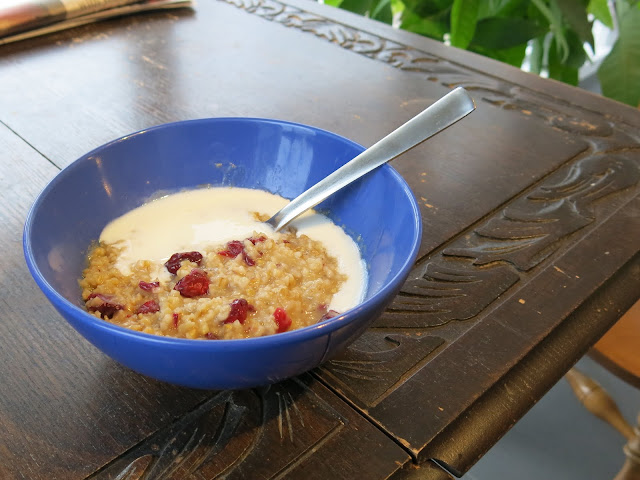Readers of this blog will know that steel-cut oatmeal has revolutionized my winter breakfasts, especially after I found a low-risk, low-maintenance way of getting the perfect taste and texture, precooking things in advance and letting them sit around to plump up nicely overnight. This year I got more adventurous, but also even lazier, and the oatmeal is, if anything, even more perfect. It’s a high-fibre, filling and low(ish) calorie way to start the day, and it keeps me going until mid-morning at least, especially if I add a few walnuts to add a protein filler. The secrets? A $20 slow cooker from the discount kitchen store, a selection of different grains to supplement the oats, far more liquid than you ever think you’ll need and patience.
The recipe is infinitely flexible, but here’s roughly what I do. Each batch lasts me for a week or so, maybe a bit less if I feel particularly hungry in the mornings.
Slow-cooked steel-cut oatmeal
generous half cup of steel-cut oats
skimpy one-third cup of other grains (I’ve used tef, amaranth and very small amounts of freekah so far, with amaranth at the top of the list for taste and texture)
2-3 cups water
1-2 cups other liquid (apple cider, coconut milk, milk, depending on mood)
generous pinch of salt
Put all the ingredients in the slow cooker and cook on low for 3-4 hours. Stir once in the middle if you remember. Allow to cool in the cooker and then store the porridge in a tupperware in the fridge. Come breakfast time, spoon out a portion into a bowl and reheat it in the microwave. Then add fruit and nuts, perhaps some cocoa nibs for bitterness and a generous splash of milk, buttermilk, yogurt or home-made kefir (which curdles slightly in the hot oatmeal). You could add honey/sugar/maple syrup too, or even jam, but I find the apple cider offers enough sweetness for my taste.
The Guardian describes tef (an Ethiopian cereal) as “the next big supergrain,” while HuffPost gives a similar moniker to freekah (wheat that’s harvested when it’s still green and then cracked and roasted), dubbing it “the next hot supergrain“. HuffPost also offers “14 reasons to eat amaranth” (an eat-everything plant — the dark green leaves are used in Caribbean cooking and known as callaloo), and says cocoa nibs are “even better for you than dark chocolate.” How can I go wrong?
I’d note I don’t like to add too much freekah, because it adds a very wheaty taste to the finished cereal. I get a wheaty taste from bread; I like my oatmeal to taste mostly of oats.
Anyone got other ideas to jazz up oatmeal?













